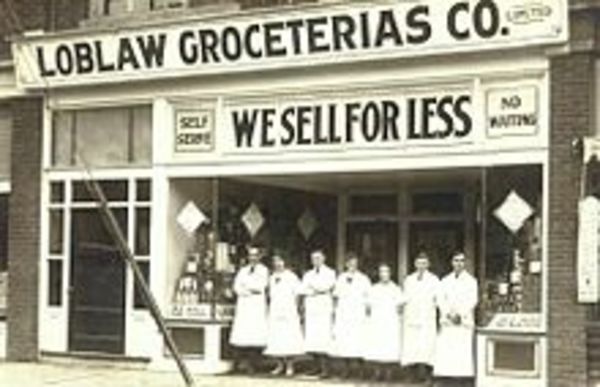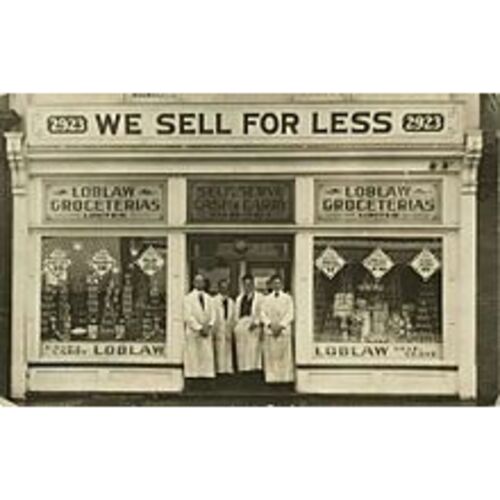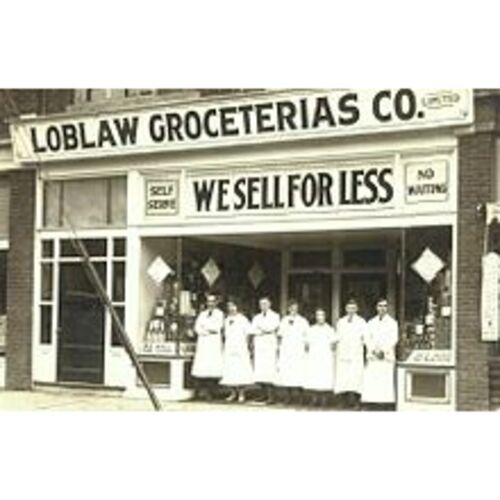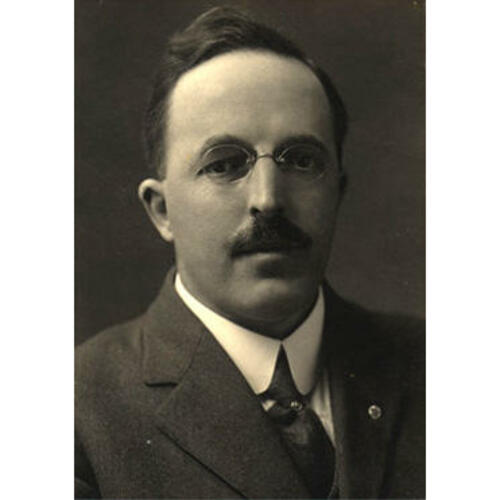
Source: Courtesy of Wikimedia Commons
LOBLAW, THEODORE PRINGLE, businessman and philanthropist; b. 1 July 1872 in Elmgrove, Simcoe County, Ont., youngest of the four children of William James Loblaw and Isabella Stevenson; m. 2 June 1897 Isabella Helen Adam (d. 27 May 1930) in Toronto, and they adopted a great-niece of his and fostered three nephews of hers, the boys taking the name Burr-Loblaw; d. 2 April 1933 in Toronto.
Theodore P. Loblaw’s early life reads like one of Horatio Alger’s stories. Born into a respectable farming family, he was only nine months old when his father was killed in an accident involving a runaway team of horses. His mother raised him with the help of her parents until her death when he was 15. Later he lived with his widowed maternal grandmother and an uncle. After being educated at the Scotch Line school in Essa Township and Alliston’s high school, he went to work in the summer of 1890 for a neighbouring farmer. He managed to put away 19 of the 20 dollars he was paid. One of his brothers gave him an additional 10 dollars and his sister a suit of clothes, and that autumn Loblaw set off for Toronto, where he found a job at Timothy Eaton*’s emporium during the Christmas rush. Laid off at the end of the season, he was hired as a clerk by William G. Cork on King Street East, one of the city’s approximately 800 grocers. Years later, a fellow employee would describe Loblaw as “the best grocery clerk he ever saw in action.” After his wages were increased from three to five dollars a week, he was able to save a dollar. “The only money I needed was for the collection plate on Sundays,” he would later recall. “I had no time or money for luxuries, entertainments, shows or vacations. I did not even board a street car the first two years I was in Toronto.”
At the end of the 19th century the grocery trade in the city was organized around a dozen wholesalers who, with other, more specialized firms, sold provisions to the stores owned by independent operators such as Cork. Barriers to entering the retail business were few, and there was a lot of movement. In 1894 Loblaw left Cork’s shop for that of a grocer on College Street. The latter moved on within a year, as did his successor, who sold the store to John Milton Cork, the son of Loblaw’s earlier employer. This transaction was no coincidence but reflected the strong friendship between the two men that would underlie their careers for almost four decades. Initially, Loblaw clerked for Cork, and then for a couple of years they were partners. But by 1900 Loblaw had taken over the enterprise, perhaps with help from his father-in-law, David Adam, and Cork was in business in another part of the city. Loblaw would attribute his early success in part to his physical fitness. Having brought “a good healthy constitution” with him when he came to Toronto, he would get up every morning at 4:00 a.m. to ride his bicycle out to the nearest railway junction and collect a supply of farm produce.
Meanwhile he had begun to attend business school during the two evenings when he was not working. His study of bookkeeping gave him insight into the importance of maintaining good records. If he was to have one big advantage over his competitors, it was that he believed strongly in systems. In 1905 he patented a loose-leaf ledger he had designed. This invention so fired his imagination that a year later he turned his store back to Cork to devote himself full-time to the Loblaw Account System Company. But in 1908, when a local manufacturer offered to buy the business, he sold out and became a silent partner to an independent grocer, Harry G. Doyle. He then prepared for his next move: opening, in July 1910, the first store in what would become a chain carrying his name. Several others soon followed. A chain had the advantage of dealing directly with suppliers, taking the profits that had previously gone to the wholesalers. Increased volumes of merchandise also allowed the chain to reduce the prices charged to customers. Loblaw would subsequently claim that “the chain store has succeeded in putting its goods on the consumers’ table at a lower price than the wholesaler can buy them for.” The company was incorporated in 1916 as Loblaw Stores Limited. Initially it offered credit and delivery according to the traditional model, but in 1918 all 16 units were switched to cash and carry, though customers were still waited on by clerks behind a counter.
Loblaw was growing restless, however, and in early 1919 he withdrew from active involvement in Loblaw Stores. His associate Frederick Eugene Robson was left to run the chain until agreement was reached in August for its sale to the fledgling Dominion Stores Limited, founded in Toronto a short time earlier by William James Pentland and his partners. Pentland assumed responsibility for the Loblaw stores in October, though the purchase was not completed until February 1920.
In March the previous year Loblaw had become manager of the United Farmers’ Co-operative Company, an offshoot of the United Farmers of Ontario. It is not known why he had accepted this position when it was offered to him. He may have overestimated his own abilities. In any event he seized the opportunity with typical energy, proposing within two weeks of his arrival a program of diversification funded by increased capitalization. Until then the company had worked through semi-autonomous local clubs to buy farm produce and sell groceries, coal, harnesses, agricultural implements, and other supplies. Loblaw introduced new operating systems, boosted sales by opening retail stores, and began marketing livestock by the carload at the Toronto stockyards.
These initiatives required greater centralization, which was resisted by veterans of the UFO. One of the UFCC founders, William Charles Good*, later described Loblaw as “a man of extraordinary energy and push,” whose “temperament was such that he wanted nothing to do with any business he could not dominate.… I don’t think he ever had any patience with, or even any knowledge of, the Co-operative Movement.” Future premier Ernest Charles Drury*, then a director of the UFO, was more positive in his assessment. He was greatly impressed with this “clean-cut, energetic young fellow,” whom he had visited at Loblaw’s home while the latter was being considered for the post. Drury felt that Loblaw was sympathetic to farmers, understood their way of life, and had good ideas. However, Loblaw later told him that UFO secretary James J. Morrison had been “actively hostile to him and put so many obstacles in his way that he felt compelled to resign.” In May 1920, after little more than a year in the job, Loblaw announced his intention to withdraw, citing the strain on his health; he left the company in July.
What had now taken his interest was the self-serve “groceteria,” a concept modelled on the cafeteria and pioneered by Clarence Saunders in Memphis, Tenn., in 1916. Loblaw may have come across Saunders’s Piggly Wiggly stores while travelling for the UFCC in the United States. One evening he had watched a woman leave one of his own shops when she could not stay until a clerk was free to assist her: “If this stock had been accessible to that lady, she could have waited upon herself.” In June 1919 he and Cork, operating as a partnership, opened their first store on the self-serve model on Dundas Street in Toronto’s west end; a second followed later that year. Each had a similar layout that led customers from a turnstile at the entrance past shelves of merchandise to the cashier’s desk and another turnstile at the exit. The stores offered a selection of canned and bottled goods, teas, coffees, biscuits, cereals, flour, butter, and cheese. All packages were clearly marked with the quantity, price per pound, and total amount.
The number of staff needed to run such outlets was less than half that required by a full-service store. Any losses that might result from the merchandise being on open shelves was counterbalanced by increased sales. There was some resistance to the new approach. While many customers were willing to save money by serving themselves and taking their purchases home, Cork told the Canadian Grocer in December 1919 that “there are a certain class of customers who expect credit, clerk service, delivery and expensive labels, and are willing to pay for what they want.”
Loblaw Groceterias Limited was incorporated in August 1920, with Loblaw and Cork as the principal shareholders; the name was changed in April the following year to the Loblaw Groceterias Company Limited. The chain expanded rapidly across Ontario from 4 stores in 1921 to 99 a decade later. Comparative operating data for the period are scarce, but they suggest that Loblaw units were, on average, two or three times larger than Dominion stores, the company’s largest competitors, and outsold the latter by five or six times. Certainly, they were more profitable. By the early 1930s their sales were said to total more than $15 million annually, and Canadian Grocer would observe in 1933 that their net return was “recognized as the largest on the American continent for a grocery chain.”
In the fall of 1924 the Loblaw banner had been carried to Buffalo, N.Y. An American subsidiary, Loblaw Groceterias Incorporated, was formed in partnership with local interests. Within three years it was running almost two dozen stores in western New York State and was making money. This success emboldened Loblaw to recapitalize the American company and expand into Chicago. Because of the size of the market in that city and the need to absorb heavy advertising costs and overhead, the approach taken there was more aggressive than that employed in Buffalo. Within a year after the first store in Chicago opened in June 1928, there were 53 outlets; two years later the number had risen to 75. But profits would prove elusive, and Loblaw’s Chicago operations would eventually be sold to the Jewel Tea Company in 1932, while those in New York, Pennsylvania, and Ohio were retained.
Since 1928 stores in Ontario had been supplied from a large, modern warehouse on Fleet Street (Lake Shore Boulevard) at Bathurst. Served by a rail siding, it boasted the latest systems for filling orders, a bakery, and facilities for roasting and grinding coffee, blending teas, and packaging butter, candy, and other products. Around this time Loblaw introduced the concept of packaged meat that could be sold on a self-serve basis. Great emphasis was placed on hygiene. From his early days in the business he remembered groceries that were “exposed to the elements” and prey to insects and mice. He had learned the value of “maximum cleanliness in the handling of foodstuffs” from Cork’s mother and believed that it contributed “in no small way to the health of a community.” The warehouse also contained a recreational club for the company’s 800 employees, including bowling alleys, billiard and card rooms, and a concert hall. The centre was opened with great fanfare in October 1928.
By now Loblaw was rich enough to make large gifts to charity. In late 1926 he had donated $100,000 to help establish the Stevenson Memorial Hospital in Alliston, named in honour of his maternal grandparents. The Toronto Western Hospital received $1,000,000 from Loblaw and Cork towards a new building in early 1929. Loblaw chaired the financial campaign of the Federation for Community Service, an organization that raised money for local charities, in 1924 and was appointed to a three-man committee set up by the city that year to review its purchasing practices. A long-time member of the Kiwanis Club of Toronto, he served on its executive and as a director of the west-end branch of the Young Men’s Christian Association.
His wealth also allowed Loblaw to indulge in nostalgia. On the walls of his large office overlooking Lake Ontario were displayed a winter scene of the road near Alliston along which he had once trudged to school and Paul Peel*’s The young biologist (1892), a painting he loved because its juvenile subject was “just having a good time.” In 1927 Loblaw bought back his grandparents’ farm as a place where he could relax during his leisure hours, incorporating the original frame farmhouse from the 1850s into a modern home and expanding the property to some 500 acres. Here he developed a herd of about 100 registered Holsteins and raised Yorkshire hogs. The animals were shown at the Canadian National Exhibition and the Royal Agricultural Winter Fair and won Loblaw a number of ribbons. He also added a silver fox farm and a golf course.
While at his farm in July 1928, Loblaw was thrown from a horse and suffered a fractured thigh. Pneumonia followed, and for a time his life was in danger. After recovering his health, he decided to sell part of his holdings in the Loblaw Groceterias Company to ensure continuity should he die unexpectedly or become incapacitated, but also to raise funds to invest in the American operation. To this end he gave Merrill, Lynch, and Company of New York the right to purchase some of his shares. Under certain conditions this option could be turned into a controlling interest in the company. Merrill, Lynch went about finding a buyer and had all but concluded a merger with Dominion Stores, in spite of opposition from minority Loblaw shareholders. But the deal died in November 1929 because Dominion was prevented by the onset of the Great Depression from raising the necessary funds.
A few months before his untimely death in the spring of 1933 from meningitis following a minor sinus operation, Loblaw experienced a strong religious reawakening through the influence of the Oxford Group. Its members, active in churches of all denominations, endeavoured to achieve a “spiritual quality of life under the guidance of the Holy Spirit.” He told an interviewer shortly before his death that, though he had been brought up in the Methodist and Presbyterian churches, he had never been “really religious.” But “I came to realize I had been asking God for everything during my life. Now … I ask God what He wants me to do for Him. I have found happiness in religion and I enjoy my church in a way I never did before.” Loblaw gave public witness to his “changed life,” shared his insights into the shortcomings of big business, and began to introduce his friends and associates to his new faith.
It was intimated by some who knew him that he planned to reorganize his business interests to reflect his profound conversion, but he had not done so by the time he died. His will included generous bequests to various relatives and enlarged on his previous gifts to the Stevenson Memorial Hospital, the Toronto Western Hospital, and the Kiwanis Club of Toronto for its work with underprivileged boys. Emmanuel College at the University of Toronto was also a beneficiary of his estate, which was valued at over $2 million. Loblaw was succeeded as president of the company by his friend and partner J. Milton Cork, while most of his shares ended up in a charitable trust. They would remain there until Willard Garfield Weston* acquired them following his purchase of Cork’s shares in 1947.
Though Loblaw had been a member of Wesley United Church in Mimico (Toronto), his funeral was held in the more centrally located Timothy Eaton Memorial Church on St Clair Avenue so that many of his friends and employees could attend. There, only a few weeks before, he had been an honorary pall-bearer for his rival in the grocery business, W. J. Pentland. He was buried in the Alliston Union Cemetery beside his wife, who had died three years earlier. An editorial in the Toronto Daily Star regretted the death of this “citizen of great accomplishments in the field of merchandising … in the prime of life.” Although he sometimes called himself “hard-boiled,” the paper observed, “he was always big-hearted and generous and given to kindly deeds. His love for children, his consideration for the sick and the poor, his readiness to help any worthy enterprise were outstanding.” In business circles Theodore P. Loblaw was remembered for the way he had transformed the grocery business in Canada and changed how customers shopped.
A clipping of an interview of Theodore Pringle Loblaw by Strathearn Boyd Thomson published in Hush (Toronto) between 25 Feb. and 2 April 1933 is held at the George Weston Limited Corporate Arch. (Toronto).
AO, TC 2285 (The Loblaws Groceteria Ltd.); TC 4077 (Loblaws Stores Limited). Ont., Ministry of Govt. and Consumer Services, Companies and personal property security branch (Toronto), 18999 (Loblaws Limited). Univ. of Guelph Library, Arch. and Special Coll. (Ont.), XA1 MS A126009 (Leonard Harman/United Co-operatives of Ontario Coll.), file 2 (minute books for the United Farmers’ Co-operative Company, 1917–20). Daily Mail and Empire, 3 April 1933. Farmers’ Sun (Toronto), 2 April 1919. Financial Post (Toronto), 20 Feb. 1925, 17 Dec. 1926, 24 Feb. 1928, 14 Nov. 1929, 19 March 1932, 8 April 1933. Globe, 3 April 1933. Herald (Alliston, Ont.), 3 Feb. 1927. Toronto Daily Star, 4 Oct. 1928; 26, 27 Feb. 1929; 8 Feb., 3, 4 April 1933. B. E. C. Boothman, “‘A more definite system’: the emergence of retail food chains in Canada, 1919–1945,” Journal of Macromarketing (Boulder, Colo.), 29 (2009): 21–36. Canada Gazette, 4 Nov. 1916: 1495. Canadian Grocer (Toronto), 21 March, 30 May, 26 Dec. 1919; 12 March 1920; 30 June 1922; 7 April 1933. Directory, Toronto, 1894–1900. E. C. Drury, Farmer premier: memoirs of the Honourable E. C. Drury (Toronto, 1966). W. C. Good, Farmer citizen: my fifty years in the Canadian farmers’ movement (Toronto, 1958). The Layman with a Notebook, What is the Oxford Group? (London, 1933). National encyclopedia of Canadian biography, ed. J. E. Middleton and W. S. Downs (2v., Toronto, 1935–37), 1: 293–98. B. G. Newton, The fairy godfather of the Boys’ K-Clubs of Toronto (Toronto, 1940; photocopy of pamphlet in author’s possession). Who’s who in Canada, 1930/31.
Cite This Article
Stephen A. Otto, “LOBLAW, THEODORE PRINGLE,” in Dictionary of Canadian Biography, vol. 16, University of Toronto/Université Laval, 2003–, accessed January 1, 2026, https://www.biographi.ca/en/bio/loblaw_theodore_pringle_16E.html.
The citation above shows the format for footnotes and endnotes according to the Chicago manual of style (16th edition). Information to be used in other citation formats:
| Permalink: | https://www.biographi.ca/en/bio/loblaw_theodore_pringle_16E.html |
| Author of Article: | Stephen A. Otto |
| Title of Article: | LOBLAW, THEODORE PRINGLE |
| Publication Name: | Dictionary of Canadian Biography, vol. 16 |
| Publisher: | University of Toronto/Université Laval |
| Year of publication: | 2016 |
| Year of revision: | 2016 |
| Access Date: | January 1, 2026 |






